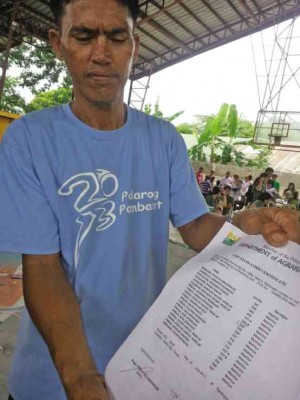
IN BARANGAY (village) Lourdes inside Hacienda Luisita in Tarlac City, Bernardo Pineda shows a lot allocation certificate where 17 beneficiaries opted to form a group and receive adjacent lots, with a total area of 11.2 hectares, near the Subic-Clark-Tarlac Expressway. JO MARTINEZ-CLEMENTE/INQUIRER CENTRAL LUZON
CITY OF SAN FERNANDO—Around 90 percent of 6,212 farmworkers in Hacienda Luisita in Tarlac province have signed the documents required to make the titles transferring to them the bulk of the sugar estate owned by the family of President Aquino, Agrarian Reform Secretary Virgilio de los Reyes said.
The signing of the lot allocation certificates (LAC) and applications to purchase and farmer’s undertaking (APFU) by majority of farmworkers in the 10 villages in the 6,443-hectare estate has enabled the Department of Agrarian Reform (DAR) to submit proof to the Registry of Deeds to register the certificates of land ownership award (CLOAs) of the beneficiaries, De los Reyes said in a statement.
President Aquino said the CLOAs should be out by September.
Ambala protest
The Alyansa ng mga Manggagawang Bukid sa Asyenda Luisita (Ambala) has asked the Supreme Court to void the LAC and APFU.
De los Reyes said the APFU was “not a new animal bred by this administration.”
“The signing of the APFU has long been required since the first day of [Comprehensive Agrarian Reform Program (CARP)] implementation in 1988,” he said.
In Hacienda Luisita, each beneficiary is set to get 6,600 square meters from out of 4,099 ha, the final size of the CARP-covered land.
These are to be paid within 30 years at a total cost of between P60,000 and P70,000.
What the CARP put under compulsory coverage in 1989 were 4,915 ha, according to the July 5, 2011, decision of the Supreme Court that ordered the distribution of land and revocation of the stock distribution program between the Tarlac Development Corp. and 6,296 farmworkers through the Hacienda Luisita Inc. (HLI).
The coverage area shrunk to 4,099 ha because on order of the high court, the DAR deducted the 500 ha sold to the Rizal Commercial Banking Corp. and the 80.51 ha sold for the construction of sections of the Subic-Clark-Tarlac Expressway. The DAR also retained less than 500 ha as common areas, like roads, canals and firebreaks.
Willingness to pay
Anthony Parungao, DAR undersecretary for legal affairs, said qualified farmworkers who did not come to the raffle for lot allocation from July 18 to
Aug. 21 in their villages could go to the DAR provincial office to get their LAC and sign the APFU, which is proof they are willing to pay and till the lots.
But De los Reyes said the refusal of any farmer-beneficiary to sign the APFU “is a ground to be stricken out of the list of beneficiaries and be replaced by other qualified beneficiaries.”
That was because the APFU is a commitment to pay the land, make it productive and bind the beneficiaries to comply with agrarian reform laws, he said.
While Parungao said the signing by 90 percent of beneficiaries indicated their “cooperation,” a leader of Ambala accused the DAR of using “deceit and intimidation, with the support of the military and the police.”
Drawing of lots
“This is more to please its owners [including] President Aquino,” Florida Sibayan, acting Ambala chair, said in a statement.
Sibayan said the DAR should not have drawn the lots through “tambiolo” (raffle drum) and should have recognized instead the “bungkalan” (tilling) system through which the farmworkers assigned lots among themselves.
Ambala continued to oppose paying the Cojuangco family for the land they would get, saying they have already paid this through their labor as stockholders of HLI since 1989.
But De los Reyes said the DAR is implementing the order of the Supreme Court to compensate the landowner. Tonette Orejas, Inquirer Central Luzon